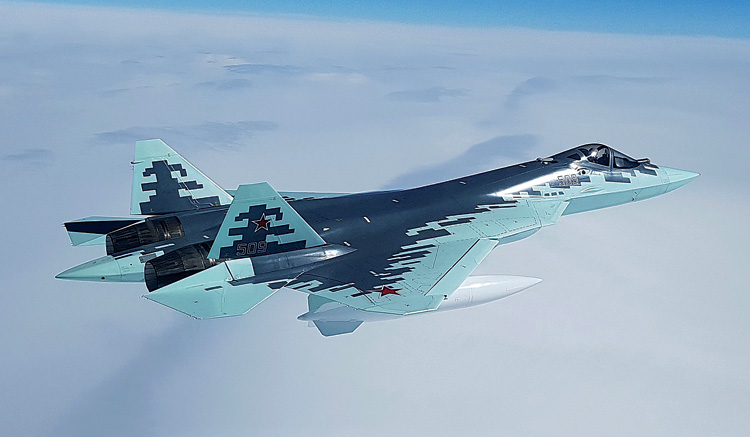- Prime Minister Narendra Modi inaugurates Aero India 2023 in Bengaluru; Releases Commemorative Stamp
- Defence Secretary meets delegations from Saudi Arabia, USA and Oman on the sidelines of Aero India 2023
- Foreign Ministers of 32 countries to attend Aero India 2023
- Embraer showcases the C-390 Millennium at Aero India 2023
The Su-57 Fighter Jet: New Generation Aircraft
Su-57 fighter is capable of performing fighter and attack missions in roughly equal proportions

The Sukhoi Design Bureau, part of the UAC, developed hundreds of advanced solutions during the development of the Su-57 fighter jet. The result is an aircraft that can adjust to a pilot's level of training, has low radio, infrared, optical and sound visibility, more than 50 per cent of its surface area consists of composite materials, and pilot equipment anticipates and parries overloads.
The Su-57 is traditionally referred to as a new generation aircraft. The first thing that distinguishes the Su-57 from all other members of the family of fifth-generation aircraft in the world is its multi-functionality. The aircraft was required to meet both air-to-air missions, characteristic of an air superiority fighter, and air-to-surface strike capabilities, characteristic of a fighter-bomber.
Unlike its competitors the Su-57 fighter is capable of performing fighter and attack missions in roughly equal proportions. Besides, the Sukhoi Design Bureau had to find a compromise between different requirements: ensuring low visibility for the aircraft to gain advantages in long-range aerial combat, but also implementing the principle of high maneuverability for close air-to-air combat. The result was a fighter with maneuverability no worse than the best fourth-generation machines.
MODEL WITH CUT-OUTS
The Su-57's appearance alone makes it radically different from the fourth generation. It has a characteristic shape with sloping sides, parallel edges and the like. In addition, to ensure low visibility on the Su-57, the air-launched attack weaponry is located in the aircraft's internal compartments. The aerodynamic design of the Su-57 is unique, too. It features controls that have not previously been used on any aircraft.
METALS/NON-METALS
The Su-57's airframe has four times fewer parts than the Su-27's. More than 50 per cent of the area of the Su-57 exterior surfaces is made up of parts made of composite materials. It was composites that made it possible to make larger cladding elements, while reducing the number of fasteners and the number of conventional parts.
STEALTH IS WELCOME
To reduce visibility special measures have been implemented. These include the use of special radio-absorbing and radio-reflective materials. Shielding materials were also used, in particular, on the antenna compartments. All on-board equipment, such as on the leading edges, was designed to ensure low radar visibility. Certain measures have also been implemented to reduce infrared signature. For example, engine emissions were shielded and purging of heat exchangers of on-board equipment is ensured.
Digital systems appeared on Russian aircraft quite a long time ago. When the Sukhoi Design Bureau was tasked with development of a single-seat multifunctional aircraft, this task came to the fore. Some of these solutions were tested on the Su-30MKI and Su-35 but the Su-57 was the pinnacle that was achieved. This aircraft has the entire flight deck digital.
SU-57 FOR EACH PILOT
On the one hand, a fifth-generation fighter is a fairly sophisticated machine. But on the other hand, it should be able to be flown by a medium-trained pilot. This is why the Su-57 has several levels of automation. For the least trained pilots, the aircraft can solve all tasks by itself, but with average quality. For more trained pilots, it is possible to vary the systems with which a particular task is handled. The advanced pilots, however, can delve into the level of system mode control. This way, even an intermediate level pilot can operate this aircraft with a fair degree of efficiency. Over time, however, they will be able to increase their level and start using the Su-57's full capabilities in all situations.





